North Cyprus Fauna
The variety of wildlife in Northern Cyprus is low, but there are still many interesting species to be seen, such as those of mammals and insects. Since farming is not especially intensive in North Cyprus, wildlife can often live in harmony with agriculture.
Mammals
 Foxes and
hares play in the cool of the evening and hedgehogs are common.
The Cyprus hedgehog, probably introduced from South Africa, has
one distinguishing feature which makes it plainly different from
the common European hedgehog - it has extremely long ears.
There is an indigenous species of cow that is bred at a Government
run farm in Çatalköy. The Cyprus moufflon is an ancestor
of the modern day sheep. Sadly it was hunted almost to the point
of extinction and now survives, in small number, in the Paphos forest
in the South.
Foxes and
hares play in the cool of the evening and hedgehogs are common.
The Cyprus hedgehog, probably introduced from South Africa, has
one distinguishing feature which makes it plainly different from
the common European hedgehog - it has extremely long ears.
There is an indigenous species of cow that is bred at a Government
run farm in Çatalköy. The Cyprus moufflon is an ancestor
of the modern day sheep. Sadly it was hunted almost to the point
of extinction and now survives, in small number, in the Paphos forest
in the South.

Bird Watching
 It
is possible to watch 347 different species of bird in Cyprus. However,
only 46 of these are native of Cyprus, and 7 of these are the endemic
sub-species (that is only found in Cyprus).
It
is possible to watch 347 different species of bird in Cyprus. However,
only 46 of these are native of Cyprus, and 7 of these are the endemic
sub-species (that is only found in Cyprus).
Turtle Watching
 Since
1992, Marine Turtle Research roup, in conjunction with the Society
for the Protection of Turtles in Northern Cyprus and the Department
for Environmental Protection, has been undertaking an annual survey,
recording the turtles activity during the summer months.
Since
1992, Marine Turtle Research roup, in conjunction with the Society
for the Protection of Turtles in Northern Cyprus and the Department
for Environmental Protection, has been undertaking an annual survey,
recording the turtles activity during the summer months.
Wild Donkeys
 Donkeys living wild and free in North Cyprus are now found in numbers in the Karpaz National Park . In this zone any sort of construction and development has been prohibited, but the use of already existing buildings remained allowed. It is this very area which makes a natural habitat for wild donkeys of Cyprus.
Donkeys living wild and free in North Cyprus are now found in numbers in the Karpaz National Park . In this zone any sort of construction and development has been prohibited, but the use of already existing buildings remained allowed. It is this very area which makes a natural habitat for wild donkeys of Cyprus.
Butterflies and Snails
 Butterflies
like the Cleopatra and swallowtail, visit the flowers and where
the strawberry tree is present as a larval food plant, the two tailed
pasha glides through the air.
Butterflies
like the Cleopatra and swallowtail, visit the flowers and where
the strawberry tree is present as a larval food plant, the two tailed
pasha glides through the air.
Spring time is the best time to observe the butterflies where as
many as fifty different migrant species pass through.
Many species of snail go into a form of summer hibernation known
as aestivation and large clumps of them adorn the steams of plants.
Snakes
The snakes have the Kyrenia mountain range as their playground,
hibernating during the winter, the warm days of spring and summer
find them in the long grass, or basking on a wall in the sun. Most
species are harmless and will quickly slither off when they are
aware of someone approaching.
Visitors should be aware of:
The Montpelier Snake: Likes to hide among the ruins, the bite can
cause painful swellings and a headache.
The Blunt-Nosed Viper: The end of its tail is yellow and hornlike.
The bite is highly dangerous and medical attention is needed immediately.
The very long black snake, which has a silver underbelly, is totally
harmless except to venomous snakes. The black snake was introduced
to the island when the poisonous snake become too numerous. The
black snake is extremely efficient at controlling the population
of the toxic variety and there are more beneficial than dangerous
snakes to be seen.
Lizards
 The
tiny lizards frolic in the summer sunshine and are extremely entertaining
as they jump and roll about in courtship or territorial combat.
When attacked by a larger creature such as cat, dog or bird of prey,
they have the ability to shed their tails, thus hopefully fooling
the attacker and making a quick gateway.
The
tiny lizards frolic in the summer sunshine and are extremely entertaining
as they jump and roll about in courtship or territorial combat.
When attacked by a larger creature such as cat, dog or bird of prey,
they have the ability to shed their tails, thus hopefully fooling
the attacker and making a quick gateway.
The ancient ruins are home to a variety of larger lizards including
the iguana- like dragon lizard; these will scuttle away rapidly
when disturbed. They are mostly shy creatures and choose under -
populated sites as their habitat.
Chameleons are to be seen among garden trees and rock crevices.
Their color will adapt to suit their surroundings and they tend
to be very slow moving creatures. Due to this slothfulness they
fall prey to domestic pets and it is not unusual for a cat to present
its owner with a chameleon.
Insects
The cicada is the noisiest insect that the visitor will encounter.
It is diurnal and the mating call of the male is extremely intrusive.
From approximately 9pm to 5am they sleep. The life span of the mature
insect is only four to six weeks, at the end of which time the female
will have mated and laid her eggs in the bark of young trees. When
the egg hatches the grub contained therein will drop to the ground
and burrow under the tree where it will attack itself to the roots
and live off the sap for two to seventeen years.
The life cycle depends very much on the tree of cicada and the latitude
at which it is born. It will emerge eventually as a shelled six-legged
creature which will climb onto an upright surface and then split
open to hatch the perfect winged mature cicada.
And the survive starts all over again.








